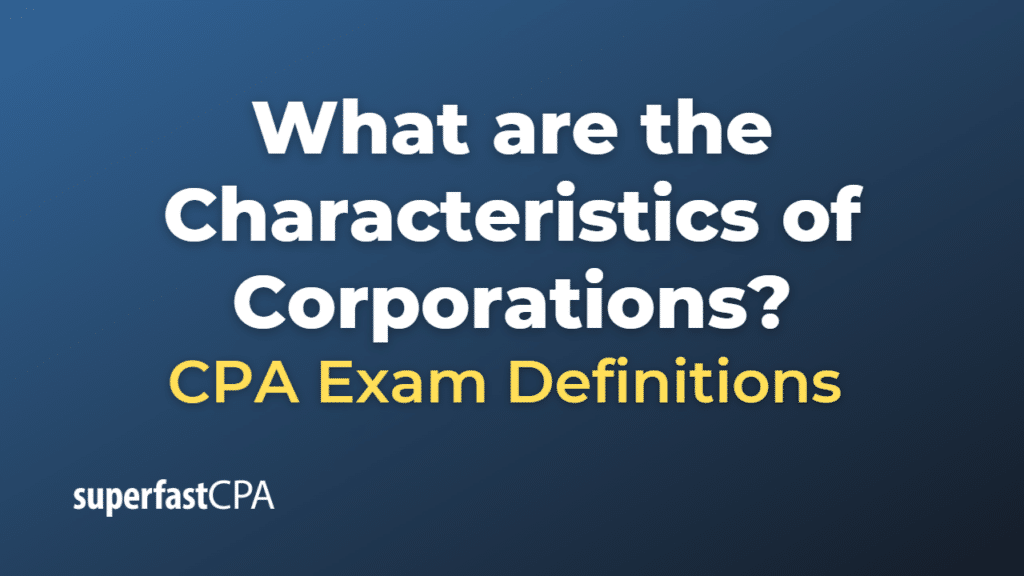Characteristics of Corporations
Corporations are a type of business organization that is formed and regulated under specific laws. They are separate legal entities from their owners (shareholders) and have distinct characteristics that set them apart from other types of business structures such as sole proprietorships and partnerships. Some key characteristics of corporations include:
- Separate legal entity: A corporation is considered a separate legal entity from its owners, which means it has its own legal rights and responsibilities. It can enter into contracts, own property, sue and be sued, and be held legally liable for its actions, debts, and obligations.
- Limited liability: Shareholders in a corporation have limited liability, which means they are generally not personally responsible for the corporation’s debts and obligations. Their liability is limited to the amount of their investment in the company. This is one of the main advantages of incorporating a business, as it protects the personal assets of shareholders from the corporation’s liabilities.
- Transferability of ownership: Ownership in a corporation is represented by shares of stock. These shares can be easily bought, sold, or transferred without affecting the corporation’s ongoing operations. This feature provides liquidity for shareholders and facilitates the raising of capital through the issuance of new shares.
- Perpetual existence: A corporation has a perpetual existence, which means it continues to exist even if its owners (shareholders) change or pass away. This characteristic provides stability and continuity for the corporation and its operations.
- Centralized management: Corporations have a centralized management structure, with a board of directors responsible for overseeing the company’s operations and making major decisions. The board of directors is elected by the shareholders, and the board, in turn, appoints the company’s officers (e.g., CEO, CFO, etc.) who manage the day-to-day operations of the corporation.
- Double taxation: One of the disadvantages of a corporation, particularly a C corporation, is the potential for double taxation. The corporation’s profits are taxed at the corporate level, and then any dividends distributed to shareholders are taxed again at the individual level. However, this issue can be mitigated through the use of S corporations, which pass through income, losses, deductions, and credits to shareholders, avoiding double taxation.
- Regulatory compliance: Corporations are subject to various federal, state, and local regulations, including corporate governance requirements, securities regulations, and tax reporting obligations. Compliance with these regulations can be more complex and time-consuming compared to other business structures.
These characteristics make corporations an attractive choice for businesses seeking limited liability protection, the ability to raise capital, and continuity of operations. However, the potential for double taxation and the increased regulatory burden should be carefully considered when deciding whether to incorporate a business.
Example of the Characteristics of Corporations
Let’s consider a hypothetical example of a corporation:
Jane and John are two entrepreneurs who have developed an innovative software product that has the potential to disrupt the market. They decide to create a corporation, called JJ Software Inc., to protect their personal assets, raise capital, and facilitate the growth of their business.
- Separate legal entity: Jane and John register JJ Software Inc. as a corporation in their state. The corporation becomes a separate legal entity, distinct from its owners (Jane and John).
- Limited liability: As shareholders of JJ Software Inc., Jane and John have limited liability protection. Their personal assets are not at risk if the corporation incurs debts or faces legal issues, as their liability is limited to their investment in the company.
- Transferability of ownership: JJ Software Inc. issues shares of stock to represent ownership in the company. Jane and John can easily buy, sell, or transfer these shares without affecting the corporation’s operations. This feature also allows them to attract investors and raise capital for future growth.
- Perpetual existence: JJ Software Inc. has a perpetual existence, which means it will continue to exist even if Jane, John, or other shareholders pass away or decide to sell their shares. This provides stability and continuity for the business.
- Centralized management: Jane and John establish a board of directors for JJ Software Inc., responsible for overseeing the company’s operations and making major decisions. The board appoints Jane as the CEO and John as the CTO, and they manage the day-to-day operations of the corporation.
- Double taxation: JJ Software Inc., as a C corporation, faces the issue of double taxation. The corporation’s profits are taxed at the corporate level, and any dividends distributed to Jane, John, or other shareholders are taxed again at the individual level. To avoid double taxation, they could consider electing S corporation status.
- Regulatory compliance: As a corporation, JJ Software Inc. must comply with various federal, state, and local regulations, including corporate governance requirements, securities regulations, and tax reporting obligations. Jane and John work with legal and financial advisors to ensure compliance with these regulations.
In this example, Jane and John chose to form a corporation for their business to take advantage of the limited liability protection, transferability of ownership, and perpetual existence offered by this type of business structure. They carefully consider the potential drawbacks, such as double taxation and regulatory compliance, and work to mitigate these issues as they grow their business.













